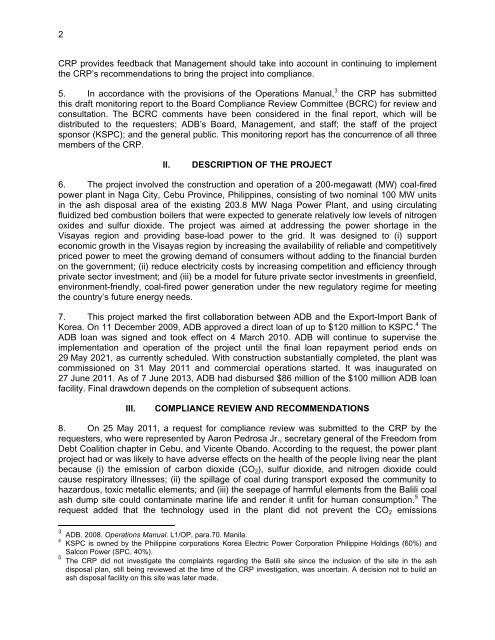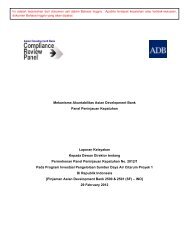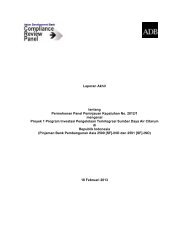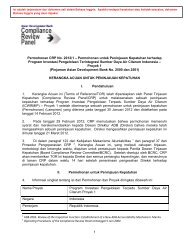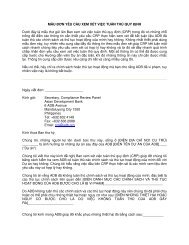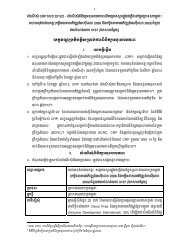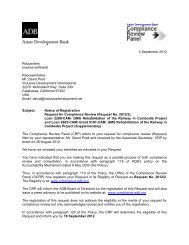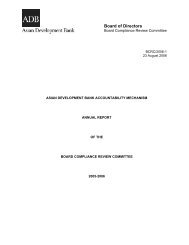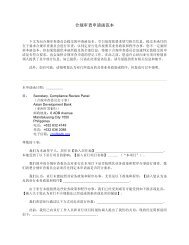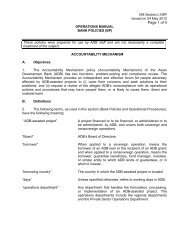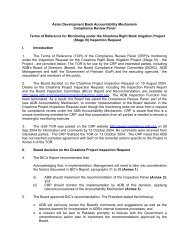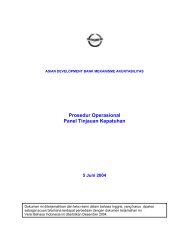Annual Monitoring Report - ADB Compliance Review Panel - Asian ...
Annual Monitoring Report - ADB Compliance Review Panel - Asian ...
Annual Monitoring Report - ADB Compliance Review Panel - Asian ...
Create successful ePaper yourself
Turn your PDF publications into a flip-book with our unique Google optimized e-Paper software.
2<br />
CRP provides feedback that Management should take into account in continuing to implement<br />
the CRP’s recommendations to bring the project into compliance.<br />
5. In accordance with the provisions of the Operations Manual, 3 the CRP has submitted<br />
this draft monitoring report to the Board <strong>Compliance</strong> <strong>Review</strong> Committee (BCRC) for review and<br />
consultation. The BCRC comments have been considered in the final report, which will be<br />
distributed to the requesters; <strong>ADB</strong>’s Board, Management, and staff; the staff of the project<br />
sponsor (KSPC); and the general public. This monitoring report has the concurrence of all three<br />
members of the CRP.<br />
II.<br />
DESCRIPTION OF THE PROJECT<br />
6. The project involved the construction and operation of a 200-megawatt (MW) coal-fired<br />
power plant in Naga City, Cebu Province, Philippines, consisting of two nominal 100 MW units<br />
in the ash disposal area of the existing 203.8 MW Naga Power Plant, and using circulating<br />
fluidized bed combustion boilers that were expected to generate relatively low levels of nitrogen<br />
oxides and sulfur dioxide. The project was aimed at addressing the power shortage in the<br />
Visayas region and providing base-load power to the grid. It was designed to (i) support<br />
economic growth in the Visayas region by increasing the availability of reliable and competitively<br />
priced power to meet the growing demand of consumers without adding to the financial burden<br />
on the government; (ii) reduce electricity costs by increasing competition and efficiency through<br />
private sector investment; and (iii) be a model for future private sector investments in greenfield,<br />
environment-friendly, coal-fired power generation under the new regulatory regime for meeting<br />
the country’s future energy needs.<br />
7. This project marked the first collaboration between <strong>ADB</strong> and the Export-Import Bank of<br />
Korea. On 11 December 2009, <strong>ADB</strong> approved a direct loan of up to $120 million to KSPC. 4 The<br />
<strong>ADB</strong> loan was signed and took effect on 4 March 2010. <strong>ADB</strong> will continue to supervise the<br />
implementation and operation of the project until the final loan repayment period ends on<br />
29 May 2021, as currently scheduled. With construction substantially completed, the plant was<br />
commissioned on 31 May 2011 and commercial operations started. It was inaugurated on<br />
27 June 2011. As of 7 June 2013, <strong>ADB</strong> had disbursed $86 million of the $100 million <strong>ADB</strong> loan<br />
facility. Final drawdown depends on the completion of subsequent actions.<br />
III.<br />
COMPLIANCE REVIEW AND RECOMMENDATIONS<br />
8. On 25 May 2011, a request for compliance review was submitted to the CRP by the<br />
requesters, who were represented by Aaron Pedrosa Jr., secretary general of the Freedom from<br />
Debt Coalition chapter in Cebu, and Vicente Obando. According to the request, the power plant<br />
project had or was likely to have adverse effects on the health of the people living near the plant<br />
because (i) the emission of carbon dioxide (CO 2 ), sulfur dioxide, and nitrogen dioxide could<br />
cause respiratory illnesses; (ii) the spillage of coal during transport exposed the community to<br />
hazardous, toxic metallic elements; and (iii) the seepage of harmful elements from the Balili coal<br />
ash dump site could contaminate marine life and render it unfit for human consumption. 5 The<br />
request added that the technology used in the plant did not prevent the CO 2 emissions<br />
3 <strong>ADB</strong>. 2008. Operations Manual. L1/OP, para.70. Manila.<br />
4 KSPC is owned by the Philippine corporations Korea Electric Power Corporation Philippine Holdings (60%) and<br />
Salcon Power (SPC, 40%).<br />
5 The CRP did not investigate the complaints regarding the Balili site since the inclusion of the site in the ash<br />
disposal plan, still being reviewed at the time of the CRP investigation, was uncertain. A decision not to build an<br />
ash disposal facility on this site was later made.


